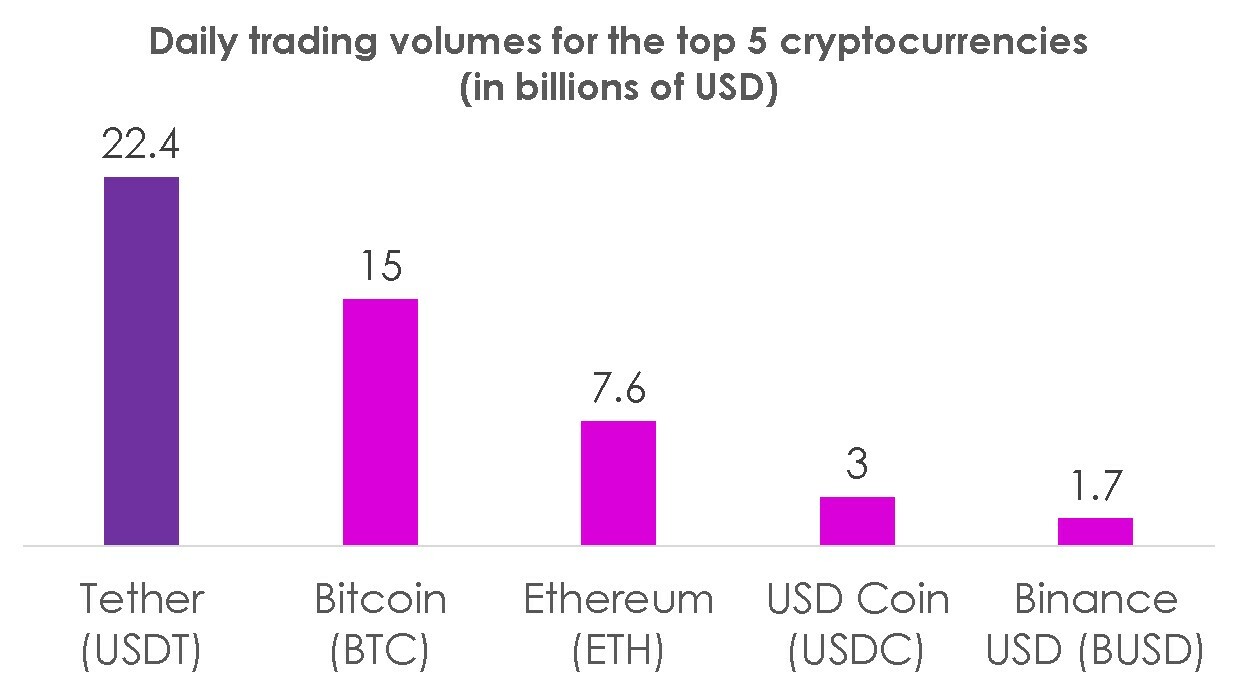Most cryptocurrencies are notoriously volatile, a feature that puts many people off using them in general.
In 2014, five years after the introduction of the world’s first crypto, Bitcoin, a new crypto coin, Tether, appeared on the market. Tether had an important, and unique at the time, characteristic – it was pegged to the US dollar at a stable 1:1 rate. With the arrival of Tether, the niche of stablecoins emerged in the crypto world.
What Is Tether (USDT)?
Tether (USDT) is a stablecoin cryptocurrency owned and supported by a leading centralised cryptocurrency exchange (CEX), Bitfinex, and its related company, Tether Ltd. Tether maintains a 1:1 peg to the USD, which is backed by Bitfinex’s commitment to pay 1 USD for each 1 USDT deposited on its platform.
Launched in 2014, Tether is the crypto world’s first stablecoin, a term used for cryptocurrencies whose market rate is pegged to some other asset, typically a widely used fiat currency, such as USD. Thanks to its stable rate, Tether is among the most popular cryptocurrencies used these days. It is highly valued among crypto users looking for rate stability in the cryptocurrency world, which is characterized by massive levels of volatility.
Many of these users purchase Tether in order to then earn interest from staking and liquidity pools on decentralised finance (DeFi) platforms. Tether’s stable rate helps ensure that your interest earned from staking will not be wiped out by a decline in the coin’s swap rate.
CEX platforms are also using Tether extensively as an alternative to using key fiat currencies such as the USD, EUR, GBP, or JPY to manage their operations.
Tether’s original concept has made it the world’s leading stablecoin, as well as the third largest cryptocurrency by market cap, behind only the market’s big boys – Bitcoin (BTC) and Ethereum (ETH).
Although Tether’s market cap is lower than Bitcoin’s and Ethereum’s, it is currently the most actively traded crypto asset in the world. On 5 May 2023, Tether’s daily trading volume is listed at $22.4 billion USD, notably higher than Bitcoin’s trading volume of $15 billion.
The chart below shows daily trading volumes on 5 May 2023 for the world’s top 5 cryptocurrencies by market cap (source of the figures: Coingecko.com)

Who Are the Competitors of Tether?
It did not take long for Tether’s innovative stablecoin concept to be replicated by other crypto projects. Some of the earlier stablecoin projects were launched in 2014, the same year Tether emerged on the market.
As of now, there are more than 80 stablecoins listed by the popular cryptocurrency market data aggregator, Coingecko.com. Among this variety, two stablecoins stand out in terms of their popularity and trading volumes as Tether’s primary competitors – USD Coin (USDC) and Binance USD (BUSD).
Both of these coins are owned and managed by leading CEXs – USDC belongs to Coinbase, while the aptly named Binance USD (BUSD) belongs, rather unsurprisingly, to Binance.
History of Tether
Tether was launched in July 2014 under the name RealCoin on the Bitcoin blockchain using the Omni Layer Protocol, a solution built on top of Bitcoin to extend its core functionality. A few months later, in November 2014, the coin was rebranded as Tether. Tether first became available for trading in early 2015.
Originally based on Bitcoin, Tether has now expanded its availability to nearly all popular blockchains, including Ethereum and Binance Chain (BNB).
Despite a number of controversies surrounding the coin’s owner company, Tether Ltd., it has managed to maintain a very close peg to the USD throughout its history. Unlike some other, less successful, stablecoins in the market, Tether’s peg to the USD has never fluctuated much. Even when such fluctuations happened, Tether Ltd. and Bitfinex proactively and quickly managed to bring the coin back to parity, or near parity, with the greenback.
Who Is Behind Tether?
Tether, under its original name, RealCoin, was founded by three blockchain technologists from the US – Brock Pierce, Craig Sellars, and Reeve Collins. Soon after its founding, the coin was publicly associated with a Hong Kong-based startup, Tether Ltd.
Tether Ltd. is the official owner of the coin. The company is managed by CEO Jean-Louis van der Velde, a Dutch-born technology entrepreneur who has worked in Asia since the mid-1980s.
The USDT coin and its peg are maintained and supported by the Bitfinex CEX. Both Bitfinex and Tether Ltd. are owned by the same parent company, iFinex Inc., which is based out of Hong Kong.
Despite past controversies, Tether (USDT) remains the world’s most popular crypto as measured by trading volumes. Tether’s centralised ownership and control make many decentralisation “purists” uneasy. However, over nearly a decade, Tether has managed to maintain a close peg to the USDT and become the main bridging asset between crypto and fiat currencies. As long as the stability of the peg is not compromised, Tether is likely to remain among the leading and most actively traded cryptocurrencies.

